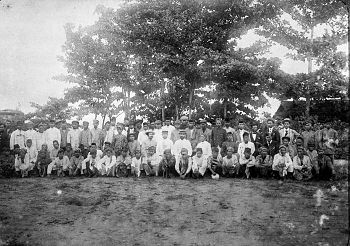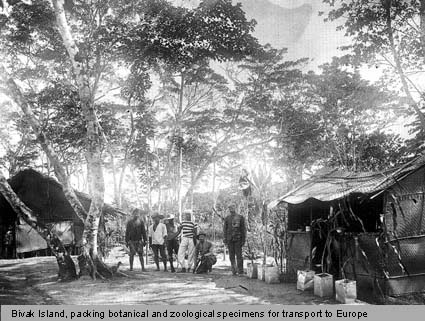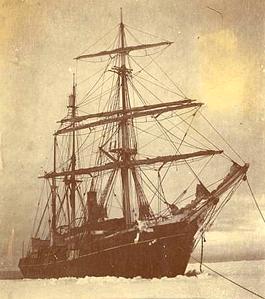South Papuan Expedition (1907)
Ekspedisi Papua Selatan (1907)
 South
Papuan expedition (1907) was the first of three series of experiments
the Dutch expedition to the southern coast of the snow-covered peaks in
Papua eternal Central. This
expedition was organized under the auspices of the Comité voor Indisch
Wetenschappelijke Onderzoekingen and Maatschappij ter Natuurkundig
Bevordering van het Onderzoek der Nederlandsche Koloniën.
South
Papuan expedition (1907) was the first of three series of experiments
the Dutch expedition to the southern coast of the snow-covered peaks in
Papua eternal Central. This
expedition was organized under the auspices of the Comité voor Indisch
Wetenschappelijke Onderzoekingen and Maatschappij ter Natuurkundig
Bevordering van het Onderzoek der Nederlandsche Koloniën.
Destination
Central
Highlands exploration expedition was organized by scientific
institutions, most also aims to establish commercial and independent
partners in the exploration of the scope of the government's national
military in the past has been done with the help of a military
detachment to an unknown coast and some inland mapping.
Participant
Leader
of the expedition was the judge and amateur biologists Hendrikus
Albertus Lorentz report contains zoology and ethnography. Jan
Willem van naval officer Nouhuys researching on geology, topography,
and meteorology, and Gerard Martinus Versteeg army doctor who is
responsible for monitoring the health and anthropology, while the
"naturalist" JM Dumas also participated because of his skill as an exploration expedition participants at the Papuan previously inaccessible. Lorentz and Versteeg certainly made a lot of photo expeditions.
Let. C. Schultz
was in command of a military convoy 45, 60 condemned inmates who made
artisan goods transport and 60 of the Dayaks of Kalimantan, indigenous
forest dwellers who served as porters, trapper, guide, bivouac makers
and skilled craftsman. In
group 3 was also a foreman, supervisor of punishment, and the number of
staff 's Lands Plantentuin in Buitenzorg (now Bogor Botanical Gardens)
who are experts in the skill and care of a collection of botanical
specimens.
The course of the expedition
With steam ship ride Valk, the expedition departed from Surabaya in April 1907. Marine
vessels are damaged without Zwaluw retractable engine and a bivouac
ship, which for a trip loaded with food for participants of the
expedition and as a repository for scientific collections on the way
home. Through
the mouth of the North River (Noordrivier) the south, which is far from
the mountainous inland and close to Wilhelmina Peak (Peak TRIKORA now)
eternal snow-capped upstream which is where the North River, they sailed
against the tide to the island bivouac in the middle of a wide river, and here Zwaluw left with a small escort ships. From there, the explorers go further inland using small boats and canoes. At various places along the banks of the river, a small bivouac-bivouac was established which eventually also abandoned. Then, in the bivouac ships and settlements along the river while going delivery of food and other supplies. In
July, they walked back to camp Alkmaar upstream and built by Lorentz
and Van Nouhuys and not far from there can be found a large plateau in
the middle of the mountains. Because it is not possible navigable river, the explorers had to continue the journey through the forest on foot. Explored a large ridge, but the plateau previously unseen in order to travel to the eternal snow can be stopped. The journey was longer and heavier than expected. Fatigue and illness began to take its toll. At the same time, most builders develop beriberi transport, food and beverages fresh thinning. Inevitably they have to walk back, leaving the bivouac around mid-October and all the participants back to P. Bivouac and both ships. On
October 22, Valk sailed into the port city of Merauke and after resting
over a month, on December 1, the group was back to Surabaya.
Scientific results
Because
the purpose of the expedition, entered the eternal snow in Central
Papua, not reached, by the originator of the expedition is said to fail.
In situ, Lorentz said that the effort is really not necessary. Scientific collections are collected and on the way home they took a trip accurate cartographic information. Detailed topography make the next experiment to snow-capped peak of the mountain was much easier.
However,
the biggest drawback is the lack of organization of the investigation
under the expert scientific staff, with particular knowledge of the
local language and culture, previous contact with local tribal groups
are mostly unknown.
Papuans
attacks also occurred to bivouac, because soldiers are tired of that
eventually went out of the camp who were in the land of origin of the
local population. An
armed attack Alkmaar Papuans to camp on July 28 resulted in the two
sides fighting each other - arrows against guns - and at least one shot
dead in Papua, so the Lorentz expressed strong protest on GubJend. in Batavia (now Jakarta) when the expedition report appears in sight. Interesting
details: the Papuans who were killed were buried, but Lorentz then
allow it to dig a grave in the anthropological collections of the
University of Utrecht. About the order, in 1918 published study extends by Johannes Arnoldus Petrus van den Broek, professor of anatomy at Utrecht.
Nimrod, not the
first choice of ship, but as in many Antarctic expeditions, one forced by
the available budget. The Nimrod sailed initially for New Zealand
on August 7th 1907.
Ekspedisi Papua Selatan (1907) adalah percobaan pertama dari 3 rangkaian ekspedisi Belanda menuju pantai selatan dari puncak gunung yang diselimuti salju abadi di Papua Tengah. Ekspedisi ini diorganisasi di bawah bantuan Indisch Comité voor Wetenschappelijke Onderzoekingen dan Maatschappij ter Bevordering van het Natuurkundig Onderzoek der Nederlandsche Koloniën.
Tujuan
Ekspedisi penjelajahan Dataran Tinggi Tengah ini diselenggarakan oleh lembaga-lembaga ilmiah, sebagian juga bertujuan komersil dan membentuk mitra independen dalam lingkup penjelajahan militer yang diselenggarakan pemerintah di masa tersebut telah dilakukan dengan bantuan detasemen militer ke pantai tak dikenal dan pemetaan beberapa bagian pedalaman.
Peserta
Pimpinan ekspedisi adalah hakim dan biolog amatir Hendrikus Albertus Lorentz yang laporannya berisi tentang zoologi dan etnografi. Perwira AL Jan Willem van Nouhuys meneliti tentang geologi, topografi, dan meteorologi, dan dokter tentara Gerard Martinus Versteeg yang bertanggung jawab untuk pengawasan kesehatan dan antropologi, sementara "naturalis" J.M. Dumas juga ikut serta karena kecakapannya sebagai peserta ekspedisi penjelajahan sebelumnya di bagian Papua yang tak dapat dimasuki. Tentunya Lorentz dan Versteeg banyak membuat foto ekspedisi.
Let. C. Schultz memegang komando atas kawalan 45 militer, 60 NaPi terhukum yang dijadikan tukang angkut barang dan 60 orang Dayak dari Kalimantan, penghuni asli hutan yang bertugas sebagai pengangkut, pemasang jerat, penunjuk jalan, pembuat bivak dan tukang yang ahli. Dalam kelompok itu juga ada 3 mandor, pengawas orang hukuman, dan sejumlah staf 's Lands Plantentuin di Buitenzorg (sekarang Kebun Raya Bogor) yang ahli dalam keterampilan dan perawatan kumpulan spesimen botani.
Jalannya ekspedisi
Dengan menumpangi kapal uap Valk, ekspedisi itu berangkat dari Surabaya pada bulan April 1907. Kapal marinir Zwaluw yang rusak tanpa mesin ditarik dan menjadi kapal bivak, yang selama perjalanan dimuati makanan untuk peserta ekspedisi dan sebagai gudang untuk koleksi ilmiah dalam perjalanan pulang. Melalui muara Sungai Utara (Noordrivier) bagian selatan, yang jauh dari pedalaman bergunung dan dekat dengan Puncak Wilhelmina (kini Puncak Trikora) yang diselimuti salju abadi yang di situlah hulu Sungai Utara, mereka berlayar melawan arus menuju Pulau Bivak di tengah sungai yang lebar itu, dan di sini Zwaluw ditinggalkan dengan sebuah kapal pengawal kecil. Dari sana, para penjelajah masuk lebih jauh ke pedalaman menggunakan perahu dan kano kecil. Di berbagai tempat sepanjang tepian sungai, bivak-bivak kecil didirikan yang akhirnya juga ditinggalkan. Kemudian, di antara kapal bivak dan permukiman sementara sepanjang sungai terjadi pengiriman bahan makanan dan perbekalan lainnya. Pada bulan Juli, mereka kembali berjalan ke hulu dan Kamp Alkmaar dibangun oleh Lorentz dan Van Nouhuys dan tak jauh dari sana dapat ditemui dataran tinggi besar dari pegunungan di tengah. Karena sungai tidak mungkin dilayari, para penjelajah harus melanjutkan perjalanan menembus hutan dengan berjalan kaki. Punggung gunung yang besar dijelajahi, namun sebelumnya dataran tinggi tak terlihat agar perjalanan ke salju abadi dapat dihentikan. Perjalanan itu lebih panjang dan berat daripada yang diduga. Kelelahan dan penyakit mulai memakan korban. Di saat bersamaan, sebagian besar tukang angkut terserang beri-beri, bahan makanan menipis dan minuman segar. Tak pelak lagi mereka harus berjalan balik, meninggalkan bivak dan sekitar pertengahan bulan Oktober semua peserta kembali ke P. Bivak dan kedua kapal. Pada tanggal 22 Oktober, Valk berlayar ke kota pelabuhan Merauke dan setelah beristirahat lewat sebulan, pada tanggal 1 Desember rombongan itu kembali ke Surabaya.
Hasil ilmiah
Karena tujuan ekspedisi itu, memasuki wilayah salju abadi di Papua Tengah, tak tercapai, oleh penggagasnya ekspedisi itu dikatakan gagal. Di situ, Lorentz mengatakan bahwa usaha itu memang tak diperlukan. Koleksi ilmiah dikumpulkan dan dalam perjalanan pulang mereka membawa informasi kartografi perjalanan yang akurat. Topografi yang terperinci membuat percobaan berikutnya ke puncak gunung yang diselimuti salju itu jauh lebih mudah.
Bagaimanapun juga, kekurangan terbesar dalam organisasi penyelidikan itu adalah tiadanya ahli di bawah staf ilmiah yang, dengan pengetahuan tertentu atas bahasa dan budaya setempat, sebelumnya bersentuhan dengan kelompok suku setempat yang kebanyakan belum dikenal.
Terjadi juga serangan orang Papua ke bivak, karena tentara yang bosan yang akhirnya pergi dari kamp yang berada di tanah asal penduduk setempat. Sebuah serangan bersenjata orang Papua ke Kamp Alkmaar pada tanggal 28 Juli mengakibatkan kedua belah pihak saling tempur - panah melawan senapan - dan setidaknya seorang Papua tewas tertembak, sehingga Lorentz menyampaikan protes keras pada GubJend. di Batavia (kini Jakarta) ketika laporan ekspedisi nampak di depan mata. Rincian menarik: orang Papua yang terbunuh dimakamkan, namun Lorentz kemudian membolehkan menggali kubur itu untuk koleksi antropologis di Universitas Utrecht. Tentang rangka tersebut, pada tahun 1918 diterbitkan studi meluas oleh Arnoldus Johannes Petrus van den Broek, profesor anatomi di Utrecht.
Photography and the exploration of Dutch New Guinea, 1907-1936 Sumber:
http://id.wikipedia.org/wiki/Ekspedisi_Papua_Selatan_%281907%29
- Ballard C, Vink S, Ploeg A. 2001. Race to the Snow: Photography and the Exploration of Dutch New Guinea 1907-1936. Amsterdam: KIT Publishers.
- Van den Broek AJP. "Das Skelett eines Pesechem", dalam: Nova Guinea 7, buku 3, hal. 233-276. Leiden: E.J. Brill, 1918.
- Lorentz HA (1907). "De N. Guinea-expeditie van de Mij. ter bevordering van het Natuurk. Onderzoek der Ned. koloniën". Tijdschrift van het Aardrijkskundig Genootschap 24: 466–71.
- Ploeg A (1995). "First Contact in the Highlands of Irian Jaya". Journal of Pacific History 30: 227–39.
- Rouffaer GP (1908). "De terugkeer en afloop der Lorentz-Expeditie naar Nederlandsch Zuid-Nieuwguinea". Tijdschrift van het Aardrijkskundig Genootschap 25: 133–44.
- Souter G. 1966. New Guinea: The Last Unknown. New York: Taplinger.

No comments:
Post a Comment